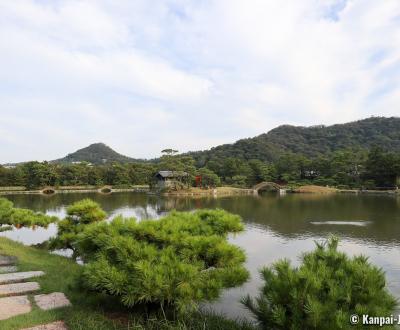Yosui-en
The Wonderful Water Garden in Wakayama
Yosui-en is a Japanese garden in Wakayama city, in the south of Kansai area. Located close to Kishu Toshogu shrine and on the waterfront, this beautiful seigneurial garden of Edo period (1603 – 1868) was designated Special Place of Scenic Beauty.
Yosui-en garden was created by Tokugawa Harutomi (1771-1853), the tenth lord of Kishu domain (former name of Wakayama prefecture) from 1818 around his estate in Nishihama in the south-west of Wakayama city. It took eight years of work to arrange the place we can still admire today.
An exceptional Japanese garden
The garden spreads on about 33,000 m² and was intended as a reception area for guests, and for the lord’s leisure as well, where he could practice traditional arts such as the tea ceremony.
Yosui-en means "contemplation garden of evergreens", but contemplation is not the only pleasure offered by the place. The garden is indeed of kaiyu-shiki style ("promenade garden") and unfurls in a very pleasant walk, all the more as visitors are scarce, under the pine trees along the pond.
Flower blossoms amateurs will not be disappointed. Even if the number of species has decreased since the early days of the garden, the passing of seasons is still made perceptible by the blooming of:
- Several irises species, especially iris laevigata and iris sanguinea in spring and the beginning of summer,
- Azaleas in May,
- Hydrangeas in June,
- Camellias in the cooler seasons of autumn and winter.

A rare Japanese garden feature: the seawater pond
The main pond spreads on more than 11,000 m² and is filled by seawater from Oura bay, which surrounds the garden, a rare feature in Japan. The other only garden with this characteristic is Hama-Rikyu in Tokyo, that was also built by the Tokugawa family.
A narrow passage from the sea allows fish to freely swim back and forth, and it is fun to see them occasionally jumping out of the water. However, patience is key to take a picture of these slippery visitors!
This unusual small lake is also adorned with:
- A central island, with a shrine to worship the kami deities protecting the place, Inari and Benten,
- The 3 arches Mitsubashi bridge and one Taikobashi bridge connecting the island to the garden,
- The tea pavilion Jissai-an for tea ceremonies (Omotesenke school).
The layout of the garden with a central island on the pond and natural mountains as the background was intended to recreate the famous Chinese landscape of the West Lake in Hangzhou.

Minato Goten Villa
The villa Minato Goten stands at the end of the course, and is open to visit for an additional fee. Its name derives from its initial location, in Wakayama’s Minato Goten district, to the south-west of the castle 🏯, along Tsukiji River. It was part of a residential complex inhabited by the Tokugawa lords after they retired from ruling the province.
The villa was built by Tokugawa Mitsusada (1627-1705) in 1698, but it was Tokugawa Shigenori (1746-1829) who made it his permanent residence. The family crest with a three-leaved hollyhock (mitsuba aoi) is the mark of the Tokugawa Clan’s Kishu branch.
Minato Goten is a magnificent example of palatial architecture of sho-in zukuri style from Edo period. It was destroyed and burnt down several times but it was completely rebuilt in 1834 following the blueprints of Edo province feudal lords estates, as it was initially built. It was transferred in its present days’ location in 2006 and it was designated Wakayama City Cultural Property in 1967.
Taking pictures inside is forbidden, however two guides are available for an English-language tour of the villa.
This wonderful Japanese garden is a literal gem on the water. Its beauty and its soothing quietness are really worth the detour. The omnipresence of water reinforces the feeling of a floating garden and the reflection of the surrounding mountains seems to recreate a different world.

